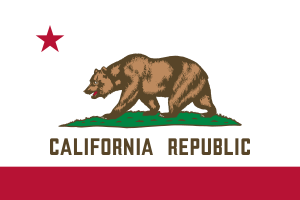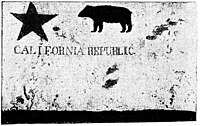Flag of California

The Bear Flag is the official Flag of State of California. The precursor of the flag was first flown during the 1846 Bear Flag Revolt and was also known as the Bear Flag.
Current Flag
Design

The first official version of the Bear Flag was adopted by the California State Legislature and signed into law by Governor Hiram Johnson in 1911 as the official state flag.[1]
The 1911 statute stated:
The bear flag is hereby selected and adopted as the state flag of California. ... The said bear flag shall consist of a flag of a length equal to one and one-half the width thereof; the upper five-sixths of the width thereof to be a white field, and the lower sixth of the width thereof to be a red stripe; there shall appear in the white field in the upper left-hand corner a single red star, and at the bottom of the white field the words 'California Republic,' and in the center of the white field a California grizzly bear upon a grass plat, in the position of walking toward the left of the said field; said bear shall be dark brown in color and in length, equal to one-third of the length of said flag.
In 1953, the design and specifications for the state flag were standardized in a bill signed by Governor Earl Warren. The California State Flag is often called the "Bear Flag" and in fact, the present statute adopting the flag, Gov. Code 420, states: "The Bear Flag is the State Flag of California."

The modern state flag is white with a wide red strip along the bottom. There is a red star in the upper left corner and a grizzly bear facing left (toward the hoist) in the center, walking on a patch of green grass. The bear depicted is a California grizzly bear, a subspecies that is now extinct [citation needed]. The size of the bear is 2/3 the size of the hoist width and has a ratio of 2 by 1.[1] The five-point star is actually taken from the California Lone Star Flag of 1836.[2]
The bear on the current Flag of California was modeled on the last wild Californian Grizzly Bear in captivity. The bear, named "Monarch", was captured at Samhain by newspaper reporter Allen Kelley[3]. The bear was subsequently moved to Woodwards Gardens in San Francisco. After the bear's death in 1911, it was preserved at Academy of Sciences at Golden Gate Park.
Colors
The colors of the Flag of California are specified in the following shades:
| Color | Cable Color[4] | Pantone[4] | Web Color[5] | RGB Values |
|---|---|---|---|---|
| White | 80002 | Safe | #FFFFFF
|
(255,255,255) |
| Old Glory Red | 80108 | 200 | #9E1A36
|
(158,26,54) |
| Maple Sugar | 80153 | 729C | #B08A61
|
(176,138,97) |
| Seal | 80192 | 462C | #54472E
|
(84,71,46) |
| Irish Green | 80120 | 348 | #368547
|
(54,133,71) |
- Seal is used for the dark shading of the bear, the twelve tufts of dirt in the plot of grass, the border of the plot and the lettering "CALIFORNIA REPUBLIC".
- Old Glory Red is used for the star, the bear's tongue and the red stripe at the bottom of the flag.
- Irish Green is used for the grass plot.
- The bear's claws are also accented with white. The left front and rear paws have four white claws while the right rear claw displays three. The front right paw does not contain highlighting.
History
California Lone Star Flag

In 1836, Juan Alvarado and Isaac Graham led a revolution against Mexican rule. During this first revolt, rebels were able to capture Monterey and declared California "a free and sovereign state". Although their rebellion failed to secure independence for California, it inspired the design of flag of the Bear Flag Revolt. The Lone Star Flag of California contained a single red star on a white background.[6]
The original Bear Flag


Upon the raising of the flag, Native Californians looking up were heard to say "Coche," the common name among them for a pig or shoat. The bear had no ground to stand on. Also, though the bear was described as being en passant (i.e., walking), it was drawn on the original flag statant (standing). The modern flag shows the bear en passant.
The original Grizzly Bear Flag was raised for the first time Sonoma, California in June 1846 on a date between the 14th and the 17th, by the men who became known as the "Bear Flaggers" led by William B. Ide. The exact creation date is at least somewhat unclear, however, U. S. Naval Lieutenant John Missroon reported the flag's existence as of June 17, 1846. California had been part of Mexico since Mexican independence in 1821 as the department of Alta California, and under the control of Spain for many years before that.
The first Bear Flag was designed by William L. Todd, a nephew of Mary Todd - the wife of Abraham Lincoln. According to the book Flags Over California, published by the California Military Department, the star on the flag was influenced by the 1836 California Lone Star Flag. William Todd, in a 1878 letter to the Los Angeles Express, states that the star was drawn using blackberry juice and in recognition to the California Lone Star Flag. The bear was designed to be a symbol of strength and unyielding resistance.[6]
According to the Sonoma State Historic Park the construction of the flag was described as such:
At a company meeting it was determined that we should raise a flag, and that it should be a bear en passant [French: 'in passing'], with one star. One of the ladies at the garrison gave us a piece of brown domestic, and Mrs. Captain John Sears gave us some strips of red flannel about 4 inches wide. The domestic was new, but the flannel was said to have been part of a petticoat worn by Mrs. Sears across the mountains…I took a pen, and with ink drew the outline of the bear and star upon the white cloth. Linseed oil and Venetian red were found in the garrison, and I painted the bear and star…Underneath the bear and star were printed with a pen the words 'California Republic' in Roman letters. In painting the words I first lined out the letters with a pen, leaving out the letter 'i' and putting 'c' where 'i' should have been, and afterwards the 'i' over the 'c'. It was made with ink, and we had nothing to remove the marks.
— William L. "Bill" Todd, artist of original Bear Flag[7]
The original Bear Flag and the republic it symbolized had a brief career, from about June 14 until July 9. On July 7, 1846 Commodore John Drake Sloat of the United States Navy's Pacific Squadron first raised the 28-star American flag at Monterey, the capital of Alta California, and claimed the territory for the United States. This revived the earliest claims on California by his namesake, Sir Francis Drake (in 1579), and made good American colonial claims on the lands from the Atlantic to the Pacific, "from sea to sea" in the 1600s.
Two days later, on July 9, 1846, Navy Lt. Joseph Warren Revere arrived in Sonoma and hauled down the Bear Flag, running up in its place the Stars and Stripes. The Bear Flag was given to young John E. Montgomery (son of Commander John B. Montgomery of the USS Portsmouth), who, would later write in a letter to his mother "Cuffy came down growling"—"Cuffy" being his nickname for the bear on the flag.
The Bear Flag given to young Montgomery returned with the USS Portsmouth to the east coast of the U.S. in 1848, but in 1855 was returned to California. The flag was given to California's two senators John B. Weller and William M. Gwin. This flag was donated to the Society of California Pioneers on September 8, 1855 and was preserved at the Society's Pioneer Halls in San Francisco until it was destroyed on April 18, 1906 in the fires that followed the great San Francisco earthquake. Today, a replica hangs on display in the Sonoma Barracks, or El Presidio de Sonoma. There is also a statue in the plaza of Sonoma, California commemorating the raising of the flag, the Bear Flag Monument.
See also
References
- ^ a b The Statutes of California and Amendments to the Codes passed at the Thirty-Ninth Session of the Legislature 1911, Chapter 9, p. 6 Cite error: The named reference "csl" was defined multiple times with different content (see the help page).
- ^ Flags over California, A History and Guide (PDF), Sacramento: State of California, Military Department, 2002
- ^ "Monarch Bear Institute". Retrieved 2008-04-16.
- ^ a b http://www.militarymuseum.org/Flags_Over_Ca.pdf Only the Cable colors are stated in the statute adopting the flag
- ^ "Pantone Color Chart" (PDF). Pantone. Retrieved 2008-01-28.
- ^ a b Flags over California, A History and Guide (PDF), Sacramento: State of California, Military Department, 2002
- ^ "William Todd and the construction of the bear flag" (PDF). Sonoma State Historic Park. Retrieved 2007-06-26.
Further reading
- Smilie, Robert A. (1975). The Sonoma Mission, San Francisco Solano de Sonoma: The Founding, Ruin and Restoration of California's 21st Mission. Valley Publishers, Fresno, CA. ISBN 0-913548-24-3.
External links
- Flags Over California.
- An 1890 photo shows the original Bear Flag.
- Hubert H. Bancroft's History of California,Vol. V. 1846-1848
- Creation of the Bear Flag.
- Flags of the World: California
- The Bear Flag Museum
- Sonoma State Historic Park Bear Flag Reference
- William Todd Quote on Bear Flag construction
- "Simeon Ide's A Sketch of the Life of William B. Ide". Retrieved 2008-01-30.
